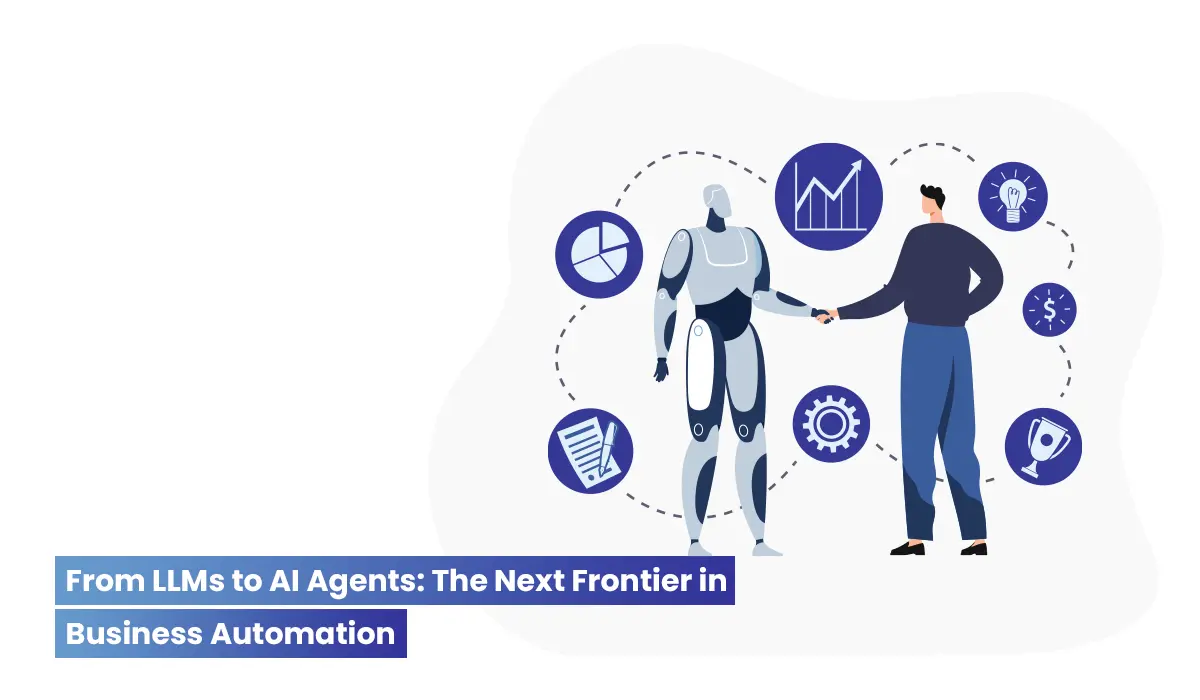AI vs. AI Agents: How LLMs, Workflows, and Autonomous Systems Are Redefining the Future

Introduction: The Evolution of Intelligent Automaton
AI-driven automation is predicted to affect up to 70% of corporate activities across sectors by 2025.
Right now, we are at a fresh junction: AI vs AI Agents.
True artificial intelligence agents think, act, and perform tasks without waiting for directions, while basic artificial intelligence (like ChatGPT) produces material or answers questions.
Maintaining competitiveness depends on knowing the change from LLMs in business to AI Agents. Let's examine closely the AI vs AI Agents.
What Are LLMs and Why Are They Game-Changers?
Large Language Models (LLMs) in Business like ChatGPT, Bard, and Claude have brought about a revolutionary change in the organizational structure of businesses.
As of the year 2024, Statista reports that there were more than 180 million people using ChatGPT.
- One of the capabilities of Large Language Models (LLMs) is the generation of high-quality marketing content, which has been shown to increase productivity by 37% in creative sectors, according to Harvard Business Review.
- Providing a concise summary of extensive business reports
- Providing assistance with fundamental coding tasks
On the other hand, Large Language Models (LLMs) in Business not only respond when they are instructed, but they do not act independently.
AI Agents vs. AI Models: What's the Difference?
Key Difference (in terms of numbers):
- LLM for passive responder (requires prodding from a human)
- AI Agent = Autonomous actor (does things on its own initiative)
LLMs are carried to a higher level by AI Agents. In order to enable real-world operations without the need for ongoing supervision, they blend natural language processing with decision-making capabilities.
A Large Language Model (LLM), for instance, is able to compose an email, but an AI Agent is able to compose, send, track, and schedule autonomous follow-up emails.
Key differences between AI Agents and AI Models (like LLMs)
.webp)
Inside AI Workflows: How Smart Systems Collaborate
AI Workflows are the embodiment of AI 2.0, which bridges the gap between artificial intelligence agents that are static and those that are fully-fledged.

Listed below are some examples of AI Workflows:
- Ticket automation for customer service and support
- Intelligent qualification of leads
- Automation in marketing that is dependent on triggers (intelligent marketing)
The efficiency of these workflows is improved, but they continue to rely on pre-programmed triggers, in contrast to AI Agents, which make decisions in a dynamic manner.
The Power of Autonomy: What Makes AI Agents Special?
Why is autonomy important?
According to Gartner's research, by 2027 half of companies would use artificial intelligence autonomous agents.
What distinguishes artificial intelligence agents?
- Their planning, prioritizing, and action modification reflect goal-oriented execution.
- Constant learning helps one to improve behavior depending on outcomes.
- Multi-step reasoning allows them to manage difficult series instead of only single cues.
AI Agents are able to orchestrate comprehensive campaign management. This includes everything from designing email sequences to assessing customer replies. This is made possible through LLM-based automation in business operations.
Real-World Use Case: An AI Agent Automating SEO
There is already a lot of buzz surrounding the use of generative AI for marketing in SEO management.
Suppose you:
- A low-ranking keyword is identified by an artificial intelligence agent.
- Sitemaps are re-submitted to Google, optimized blogs are drafted, and metadata is updated.
- It will provide you with a performance report without any assistance from a human being.

Within the realm of artificial intelligence agents, this level of generative AI for marketing in action exemplifies the true potential that lies beyond simple task assistance.
Challenges and Limitations of AI Agents Today
AI Agent Challenges and Limitations Today
AI agents are not perfect even with their promise.
Important obstacles are:
- Hallucination Risk: Based on the Accenture AI Survey, 32% of companies said "fabricated information" is their main concern.
- Agents sometimes struggle with disjointed data sources.
- Compliance and security: Control autonomous acts.
Creating AI bots requires patience, data strategy, and risk management understanding.
Where Autonomy Falls Short and What’s Next
AI Agents are impressive, but they are not yet entirely "self-aware" in their performance.
Weaknesses include:
- Insufficient comprehension of the context in its entirety
- Limited capacity to provide explanations for judgments
- Interdependence on input data that is both structured and of good quality
What next step in evolution?
Learn, work across industries, and adapt—even in new situations—with smart AI agents.
Conclusion: The Road Ahead for AI and Intelligent Agents
Choosing between AI and AI Agents is about who will lead business in the future.
LLM integration and autonomous agent planning will give businesses agility, scalability, and innovation advantages.
Anubavam helps companies build smarter, faster AI-ready systems through intelligent automation.
AI is not the future. Collaboration with AI Agents.
Are you ready?
Related Articles
Digital Transformation in 2025 = AI Transformation
Introduction: Digital No Longer Means Enough What is AI transformation, and how is it redefining digital transformation in 2025? In 2025, enterprise leaders aren’t asking, “Are we …
Read More →5 Ways AI Competitive Benchmarking Will Help You Outperform Rivals by 40% in 2025
Introduction Did you know that nearly 9 in 10 top companies actively track their competitors, but fewer than 3 in 10 believe their current AI use gives them a real edge? That gap i…
Read More →Low-Code + AI: The Dream Tech Stack for Today’s CIOs
Introduction: The Pressure on Today’s CIOs Today’s CIOs face relentless pressure: deliver more apps, faster, with fewer resources — all while driving innovation and keeping costs u…
Read More →Subscribe to the Creatrix Blog
Fresh insights on higher education, straight to your inbox.
We respect your privacy.
Want to contribute?
We welcome thought leaders to share ideas and write for our blog.
Become a Guest Author →
